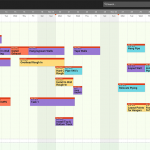If you follow the construction industry, you’ll have noticed the current buzz around alternative project delivery. This term refers to integrated project delivery (IPD), design-build (DB) and construction-manager-at-risk (CMAR) approaches, which all differ from the traditional design-bid-build process. These three distinct approaches, which we’ll explore in more detail below, have arisen in response to project owners’ desire for a less confrontational and more accountable customer experience.
Types of Alternative Project Delivery
First, it’s important to understand how each of these alternative project delivery methods differ from the design-bid-build approach. Integrated project delivery, sometimes referred to as Lean/IPD, originated out of Lean methodology as a way to involve architects, engineers, contractors and trade partners together in a project as early as possible to build trust and identify issues sooner.
The American Institute of Architects defines IPD as “a project delivery approach that integrates people, systems, business structures and practices into a process that collaboratively harnesses the talents and insights of all participants to optimize project results, increase value to the owner, reduce waste, and maximize efficiency through all phases of design, fabrication, and construction.” As with all Lean construction practices, the objective is to tap into a team’s best thinking, build better relationships, maximize efficiency and minimize waste.
However, it’s important to note that the success of an IPD project hinges on solid relationships and communication between everyone involved. It can also be challenging to work with lenders, contractors or designers who are unfamiliar with this approach.
Design-build (DB) is a system of project delivery in which a project owner, instead of entering contracts with a designer and a contractor, contracts with a single entity providing both design and construction services. According to the Design-Build Institute of America, “the designer and contractor work together from the beginning, as a team, providing unified project recommendations to fit the owner’s schedule and budget. Any changes are addressed by the entire team, leading to collaborative problem-solving and innovation, not excuses or blame-shifting.” Proponents of DB project delivery argue that by uniting the designer and contractor, an owner can avoid the often contentious dynamic that emerges as each party blames the other for delays or other problems.
While DB is advantageous for many projects, it isn’t always the answer. This approach can result in less owner control over the design, and the time and money required for contractors to bid on projects can reduce competition and lead to fewer bids overall.
Construction-manager-at-risk (CMAR) is yet another approach to project delivery in which a construction manager (CM) agrees to deliver a project within a guaranteed maximum price (GMP). A CMAR arrangement may entail project management as well as construction services, depending on the situation. This approach limits an owner’s risk of cost overruns through its commitment to a GMP.
On the flip side, this approach can also reduce an owner’s control over construction due to the shifting of responsibility from the owner to the CM. There is also the potential for a conflict of interest in cases where the CM is also a contractor on the project.
Three Answers, One Problem
These alternative project delivery approaches are being driven by a common industry need—to reduce the confrontation and risk that’s become an industry norm, and to increase accountability and efficiency. In a traditional design-bid-build project, a project owner contracts separately with a designer and a contractor. This can create an antagonistic dynamic between the designer and contractor, as each may try to blame the other when delays or cost overruns occur. The owner often ends up caught in the middle of a dispute that they may not have the ability to adjudicate.
So, it comes as no surprise that many customers are looking for more collaborative project delivery approaches. According to a recent article in Engineering News-Record, revenue for domestic CMAR projects has grown by over eighty-nine percent from 2011 to 2017. Domestic DB revenue grew by over fifty-four percent in the same time frame. While international revenue in both these areas declined, this decline was offset by gains in the domestic market.
Facilitating Collaboration
This push for collaboration reflects the depth of the impact that Lean methodology has had on the construction industry. Industry demand for greater accountability and transparency benefits contractors that have implemented Lean practices such as the Last Planner® System (LPS), particularly those that are using a digital LPS tool.
Because IPD, DB and CMAR project delivery approaches all prioritize collaboration and accountability, it’s crucial to have a reliable and easily deployable tool in which teams can schedule tasks and plan work in tandem. Owners are increasingly unwilling to be dragged into the construction blame game, and expect their project teams to be able to demonstrate their progress and justify their expenses on an ongoing basis.
While this is good news for owners, it spells trouble for contractors that have not yet adopted Lean methodology. Until they do, these firms will be at a competitive disadvantage in bidding processes against firms that can demonstrate a history of collaborative engagements that were completed on or near schedule and within budget. CMAR firms that haven’t implemented LPS are at a particular disadvantage, since they assume a significant portion of a project’s financial risk.
Fortunately, a digital implementation of LPS can be rolled out across an organization quickly, enabling faster and greater return on a company’s investment in Lean practices. As industry demand for alternative project delivery grows, contractors that are prepared to deliver the customer experience that owners are looking for will win more business and build better relationships and reputations.










